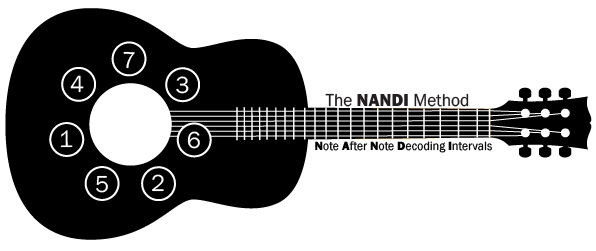Seconds
When you arrange the seven notes of the music alphabet in the order of fourths from B you get B-E-A-D-G-C-F. From the first two letters B and E, you get minor seconds B-C, and E-F. From all other letters you get major seconds. In the table below, we will show the pairs of B-C and E-F notice how the bottom and the top notes in each column are also in the order of fourths.
Minor Seconds Major Seconds Major Seconds Major Seconds Minor Seconds Minor Seconds
B-C B-C# B♭-C A-B A-B♭ A#-B
E-F E-F# E♭-F D-E D-E♭ D#-E
G-A G-A♭ G#-A
C-D C-D♭ C#-D
F-G F-G♭ F#-G
You may have noticed that we can alter the sets that were naturally minor seconds (B-C and E-F) and turn them into major seconds when one either the first note is flatted or the second note sharped. It changes the distance between the notes from one half-step to two. Similarly, we can alter the sets that were naturally major seconds (A-B, D-E, G-A, C-D, and F-G) and make them minor when either the first note is sharped or the second note flatted. This changes the distance from two half-steps to one. This same sort of pattern appears with the other major/minor intervals.
Thirds
Take a look at thirds:
Minor Thirds Major Thirds Major Thirds Major Thirds Minor Thirds Minor Thirds
B-D B-D# B♭-D G-B G-B♭ G#-B
E-G E-G# E♭-G C-E C-E♭ C#-E
A-C A-C# A♭-C F-A F-A♭ F#-A
D-F D-F# D♭-F
See? if you flat the first note or sharp the second note in a minor third it becomes a major third (three half-steps to four), and vice versa for the major thirds to minor thirds (four half-steps to three). Same with sixths:
Minor Sixths Major Sixths Major Sixths Major Sixths Minor Sixths Minor Sixths
B-G B-G# B♭-G D-B D-B♭ D#-B
E-C E-C# E♭-C G-E G-E♭ G#-E
A-F A-F# A♭-F C-A C-A♭ C#-A
F-D F-D♭ F#-D
Flat the first note or sharp the second in a minor sixth and it becomes a major sixth (eight half-steps to nine), and vice versa for the major sixths to minor sixths (nine half-steps to eight). And the same with sevenths:
Minor Sevenths Major Sevenths Major Sevenths Major Sevenths Minor Sevenths Minor Sevenths
B-A B-A# B♭-A C-B C-B♭ C#-B
E-D E-D# E♭-D F-E F-E♭ F#-E
A-G A-G# A♭-G
D-C D-C# D♭-C
G-F G-F# G♭-F
Flat the first note or sharp the second in a minor seventh and it becomes a major seventh (ten half-steps to eleven), and vice versa for the major seventh to minor seventh (eleven half-steps to ten).
Fourths
It is a little bit different with fourths and fifths because they are not major or minor, but either perfect, augmented, or diminished.
Perfect Fourths Dim. Fourths Aug. Fourths Perfect Fourths Aug. Fourths
B-E B-E♭ B-E# F-B♭ F-B
E-A E-A♭ E-A# F#-B
A-D A-D♭ A-D#
D-G D-G♭ D-G#
G-C G-C♭ G-C#
C-F C-F♭ C-F#
Here we can see that when we sharp the first note or flat the second in a perfect fourth it becomes diminished (five half-steps to four), and likewise if we sharp the second note in a perfect fourth it becomes augmented (five half-steps to six).
Perfect Fifths Dim. Fifths Aug. Fifths Dim. Fifth Perfect Fifth
E-B E-B♭ E-B# B-F B-F#
A-E A-E♭ A-E#
D-A D-A♭ D-A#
G-D G-D♭ G-D#
C-G C-G♭ C-G#
F-C F-C♭ F-C#
Fifths
Similarly for fifths, if we sharp the first note or flat the second it will become diminished (seven half-steps to six), and likewise if we sharp the second note in a perfect fourth it becomes augmented (seven half-steps to eight).
While the above charts may seem exhaustive, they are not a list of every interval. You can also use knowledge of altered scale degrees to change the quality of any given interval. Most common alterations are from major to minor, minor to major, and perfect to either diminished or augmented.
| Narrowed by one half-step | ←Original Interval→ | Widened by one half-step |
|---|---|---|
| Minor | Major | Augmented |
| Diminished | Minor | Major |
| Diminished | Perfect | Augmented |
